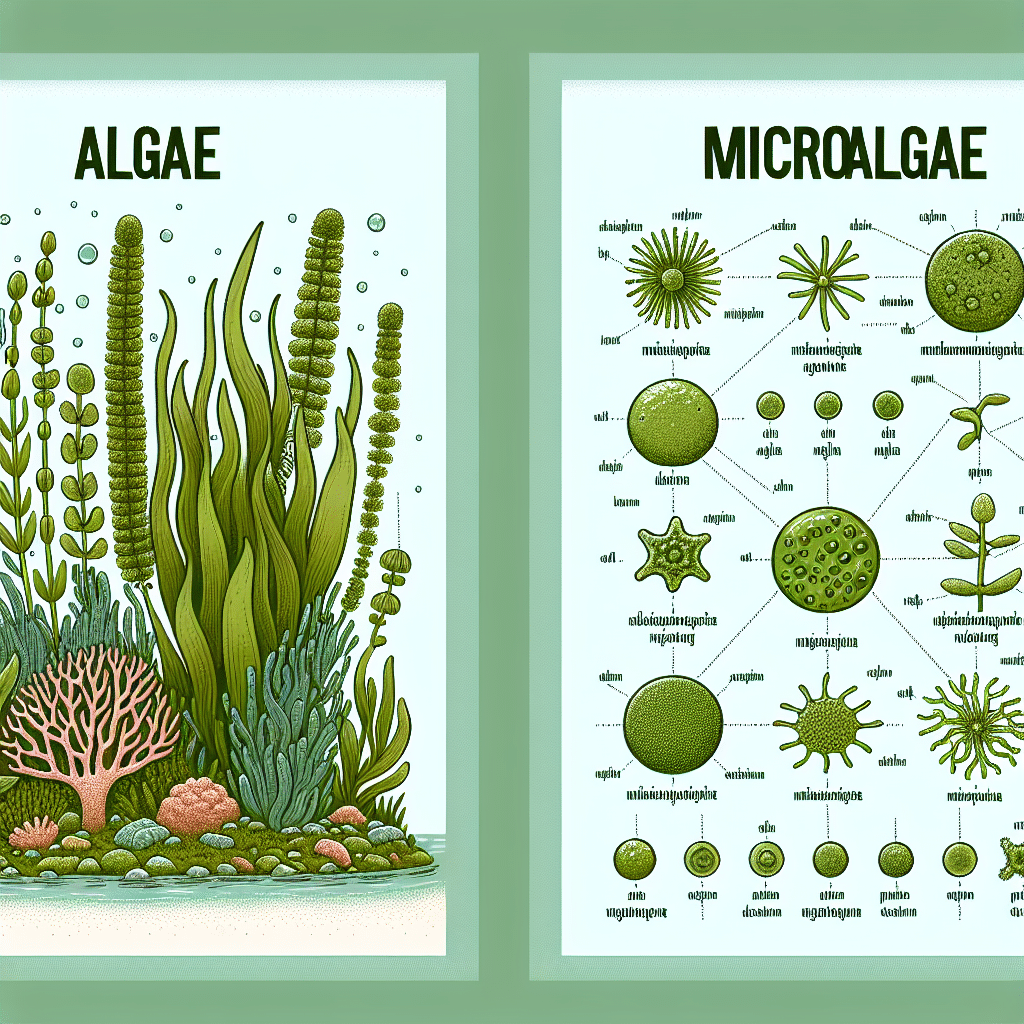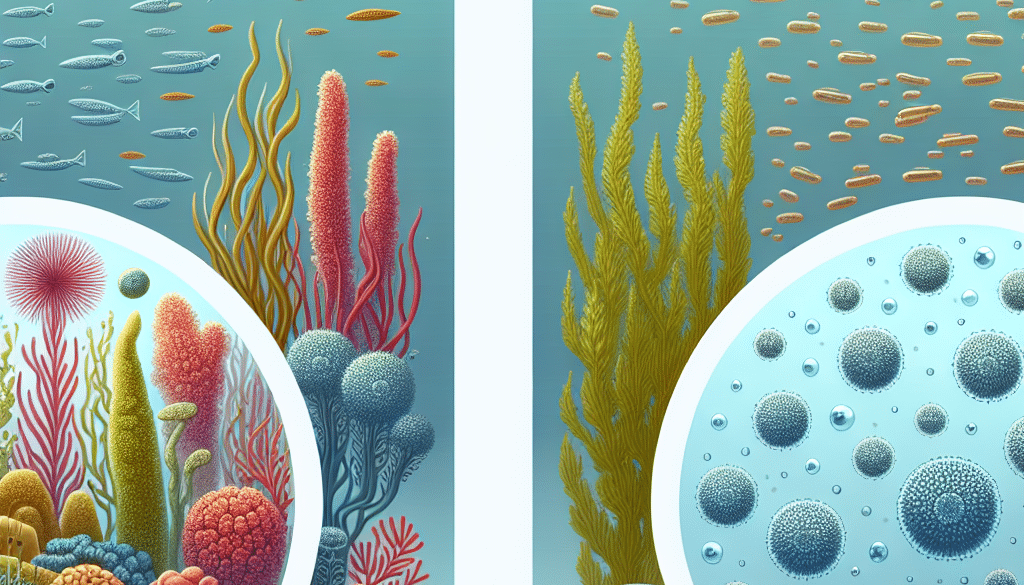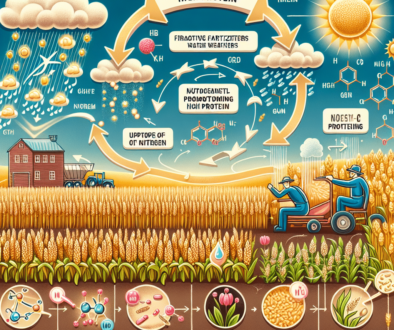What Is The Difference Between Algae And Microalgae?
-
Table of Contents
- Algae vs. Microalgae: Understanding the Key Differences
- Defining Algae and Microalgae
- What Are Algae?
- What Are Microalgae?
- Physical and Structural Differences
- Size and Complexity
- Cellular Structure
- Ecological Roles and Importance
- Oxygen Production and Carbon Sequestration
- Food Web Contributions
- Applications in Industry and Research
- Biotechnology and Biofuels
- Health and Nutrition
- Environmental Remediation
- Case Studies and Statistics
- Conclusion: The Distinct Worlds of Algae and Microalgae
- Discover ETprotein’s High-Quality Protein Products
Algae vs. Microalgae: Understanding the Key Differences

Algae are a diverse group of photosynthetic organisms that are crucial to our planet’s ecosystems. They range from the giant kelp forests to microscopic phytoplankton that drift in the ocean currents. Often, the terms “algae” and “microalgae” are used interchangeably, but they represent different categories within the algal world. This article will explore the distinctions between algae and microalgae, their ecological roles, and their importance to both the environment and various industries.
Defining Algae and Microalgae
Before delving into the differences, it’s essential to understand what algae and microalgae are and their place in the tree of life.
What Are Algae?
Algae are primarily aquatic, photosynthetic organisms that belong to the kingdom Protista. They can be found in a variety of environments, including freshwater, marine, and even terrestrial habitats. Algae can be unicellular or multicellular and vary greatly in size and form. They do not have the complex structures found in plants, such as true roots, stems, or leaves.
What Are Microalgae?
Microalgae, as the name suggests, are microscopic algae, usually found in freshwater and marine systems. They are unicellular and can exist individually or in chains or groups. Microalgae are incredibly diverse, with thousands of species contributing to various ecological functions.
Physical and Structural Differences
The most apparent difference between algae and microalgae lies in their size and complexity.
Size and Complexity
Algae can range from the microscopic, such as Chlorella, to the massive, like the giant kelp that can grow over 50 meters in length. In contrast, microalgae are always microscopic and can only be seen with the aid of a microscope.
Cellular Structure
While both algae and microalgae are eukaryotic, meaning they have a defined nucleus and organelles, their cellular structures can vary significantly. Multicellular algae have specialized structures and cells that work together, whereas microalgae are limited to the functions of a single cell.
Ecological Roles and Importance
Algae and microalgae play critical roles in their ecosystems, but their functions and impacts can differ markedly.
Oxygen Production and Carbon Sequestration
Both algae and microalgae contribute to oxygen production through photosynthesis. However, microalgae, particularly phytoplankton, are responsible for producing a significant portion of the Earth’s oxygen. They also play a crucial role in carbon sequestration, helping to mitigate the effects of climate change.
Food Web Contributions
Algae serve as a food source for a variety of marine and freshwater organisms. Microalgae, especially, are a fundamental component of the marine food web, serving as the primary producers that feed zooplankton, which in turn, support larger marine animals.
Applications in Industry and Research
Both algae and microalgae have numerous applications across different industries, from biofuels to nutrition.
Biotechnology and Biofuels
Microalgae are particularly promising in the field of biotechnology for the production of biofuels. Their high lipid content and rapid growth rates make them an ideal source for renewable energy.
Health and Nutrition
Algae are rich in vitamins, minerals, and antioxidants. Microalgae such as Spirulina and Chlorella are used as dietary supplements due to their high protein content and nutritional value.
Environmental Remediation
Both algae and microalgae can be used in environmental remediation processes, such as wastewater treatment, due to their ability to absorb heavy metals and other pollutants.
Case Studies and Statistics
Several studies highlight the potential of algae and microalgae in various sectors:
- A study on biofuel production from microalgae indicates that certain species can yield up to 300 times more oil per acre than traditional crops used for biofuels.
- Research into the nutritional benefits of microalgae has shown that Spirulina contains between 55% and 70% protein by weight, making it a potent source of vegan protein.
- Environmental projects utilizing algae for wastewater treatment have demonstrated their effectiveness in reducing nitrogen and phosphorus levels, leading to cleaner water bodies.
Conclusion: The Distinct Worlds of Algae and Microalgae
In conclusion, while algae and microalgae share some similarities, they are distinct in their physical characteristics, ecological roles, and applications. Understanding these differences is crucial for harnessing their potential in environmental management, nutrition, and sustainable energy production. As research continues to uncover the vast capabilities of these organisms, their significance in our world is only set to increase.
Discover ETprotein’s High-Quality Protein Products
If you’re interested in the nutritional benefits of algae, particularly as a source of protein, ETprotein offers a range of high-quality protein products that cater to various industries. Their organic bulk vegan proteins are ideal for those seeking non-GMO, allergen-free options with a neutral taste.
ETprotein’s offerings include Organic rice protein, clear rice protein, pea protein, clear pea protein, and other plant-based proteins, all characterized by their high purity and quality. For more information or to sample their products, please contact ETprotein.
About ETprotein:
ETprotein, a reputable protein and L-(+)-Ergothioneine (EGT) Chinese factory manufacturer and supplier, is renowned for producing, stocking, exporting, and delivering the highest quality organic bulk vegan proteins and L-(+)-Ergothioneine. They include Organic rice protein, clear rice protein, pea protein, clear pea protein, watermelon seed protein, pumpkin seed protein, sunflower seed protein, mung bean protein, peanut protein, and L-(+)-Ergothioneine EGT Pharmaceutical grade, L-(+)-Ergothioneine EGT food grade, L-(+)-Ergothioneine EGT cosmetic grade, L-(+)-Ergothioneine EGT reference grade and L-(+)-Ergothioneine EGT standard. Their offerings, characterized by a neutral taste, non-GMO, allergen-free attributes, with L-(+)-Ergothioneine purity over 98%, 99%, cater to a diverse range of industries. They serve nutraceutical, pharmaceutical, cosmeceutical, veterinary, as well as food and beverage finished product distributors, traders, and manufacturers across Europe, USA, Canada, Australia, Thailand, Japan, Korea, Brazil, and Chile, among others.
ETprotein specialization includes exporting and delivering tailor-made protein powder and finished nutritional supplements. Their extensive product range covers sectors like Food and Beverage, Sports Nutrition, Weight Management, Dietary Supplements, Health and Wellness Products, and Infant Formula, ensuring comprehensive solutions to meet all your protein needs.
As a trusted company by leading global food and beverage brands and Fortune 500 companies, ETprotein reinforces China’s reputation in the global arena. For more information or to sample their products, please contact them and email sales(at)ETprotein.com today.












